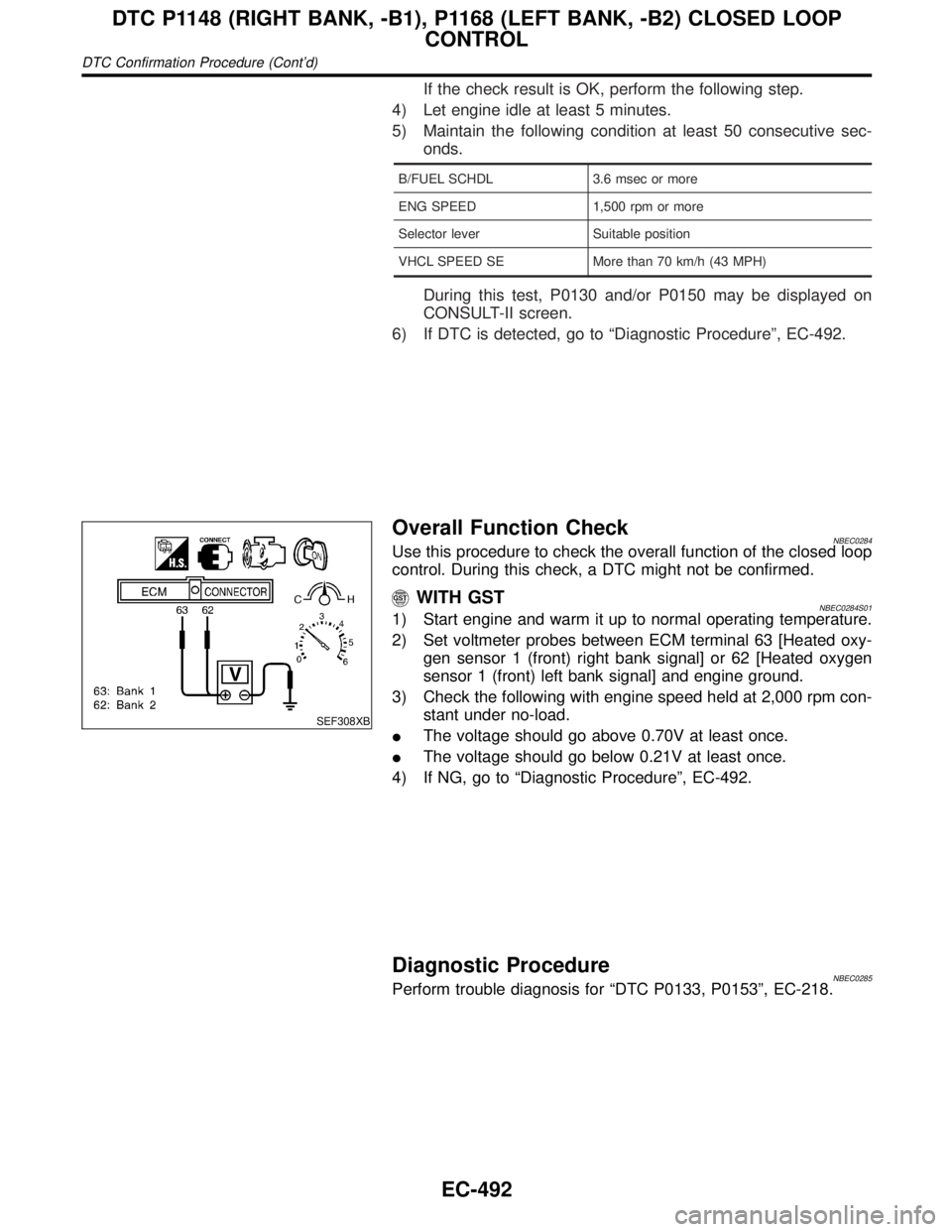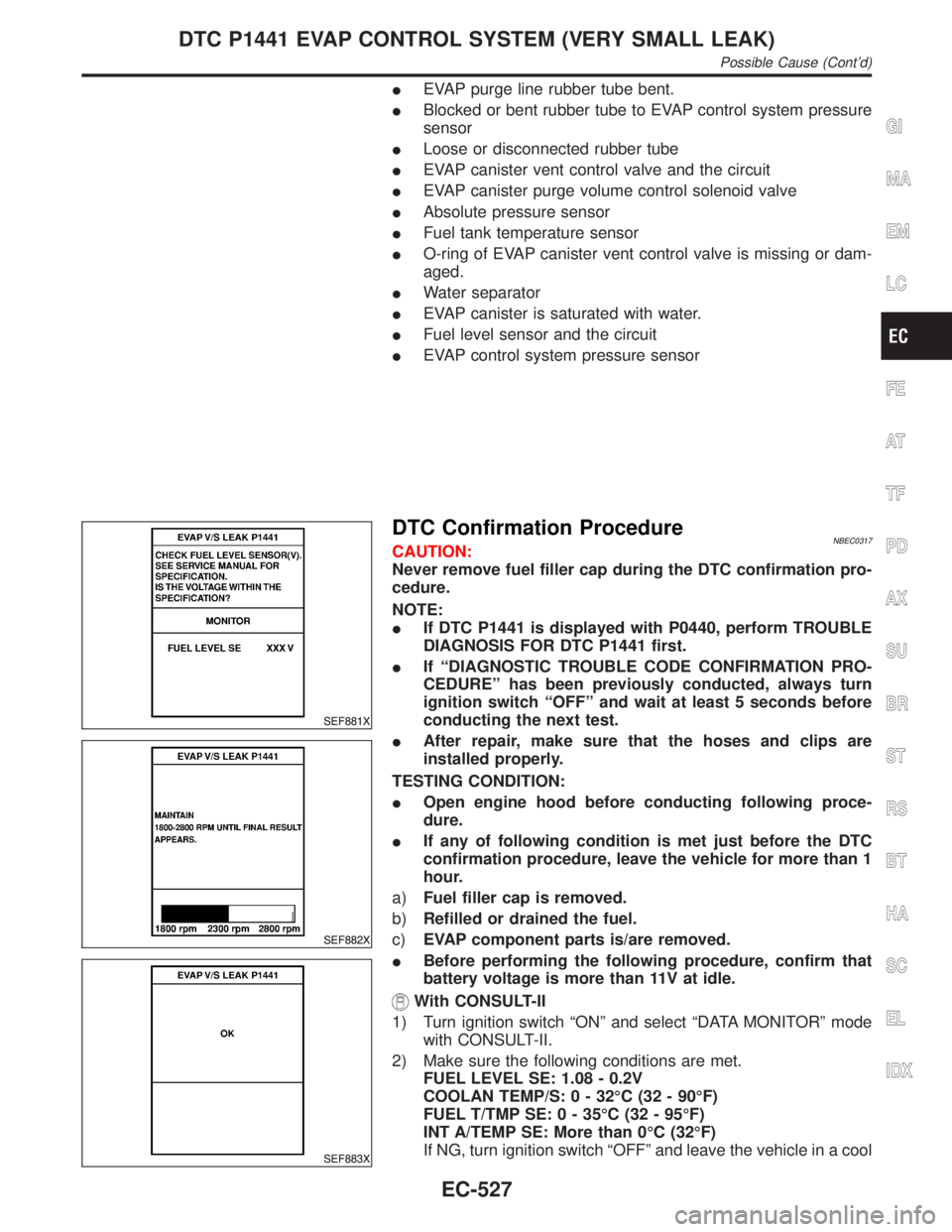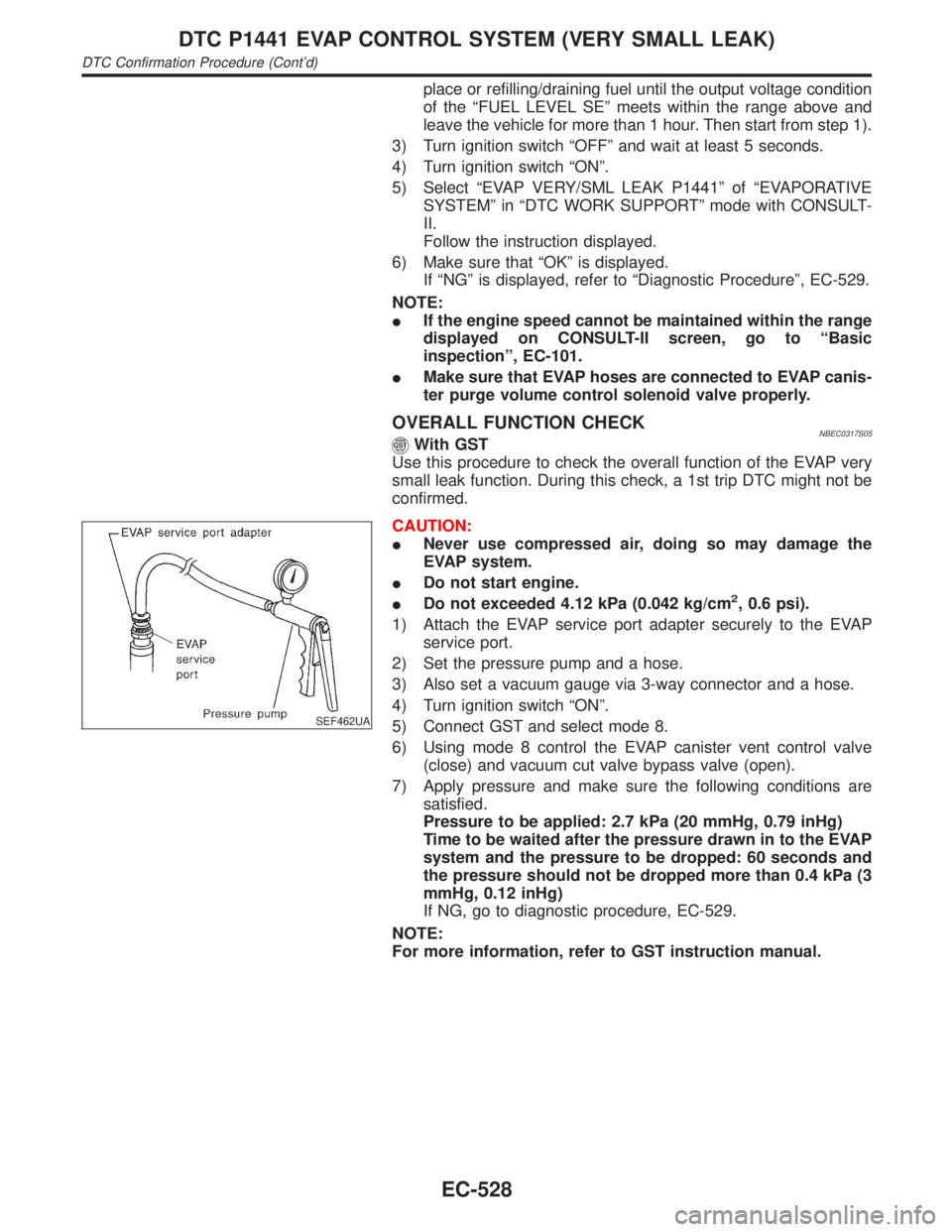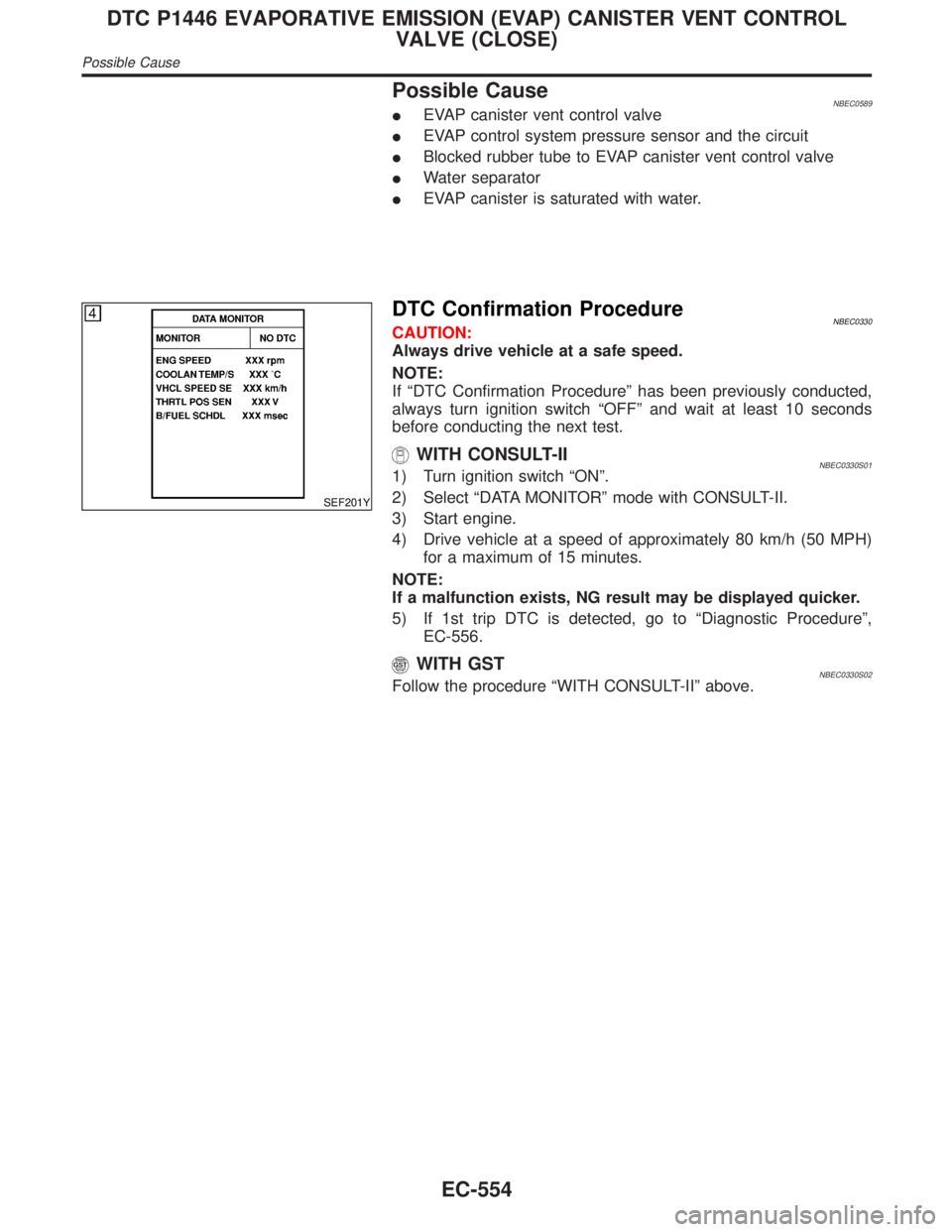2001 INFINITI QX4 display
[x] Cancel search: displayPage 993 of 2395

DescriptionNBEC0523If DTC P1130 is displayed with P1165, first perform trouble diag-
nosis for DTC P1165, EC-493.
SYSTEM DESCRIPTIONNBEC0523S01
Sensor Input Signal to ECMECM func-
tionActuator
Throttle position sensor Throttle position
Swirl control
valve con-
trolSwirl control valve control sole-
noid valve
"Vacuum signal
Swirl control valve actuator
"
Swirl control valve Ignition switch Start signal
Crankshaft position sensor (POS) Engine speed (POS signal)
Crankshaft position sensor (REF) Engine speed (REF signal)
Mass air flow sensor Amount of intake air
Engine coolant temperature sensor Engine coolant temperature
This system has a swirl control valve in the intake passage of each
cylinder.
While idling and during low engine speed operation, the swirl con-
trol valve closes. Thus the velocity of the air in the intake passage
increases, promoting the vaporization of the fuel and producing a
swirl in the combustion chamber.
Because of this operation, this system tends to increase the burn-
ing speed of the gas mixture, improve fuel consumption, and
increase the stability in running conditions.
Also, except when idling and during low engine speed operation,
this system opens the swirl control valve. In this condition, this
system tends to increase power by improving intake efficiency via
reduction of intake flow resistance, intake flow.
The solenoid valve controls swirl control valve's shut/open condi-
tion. This solenoid valve is operated by the ECM.
Throttle position
sensor (Idle posi-
tion)Engine speedSwirl control valve
control solenoid
valveSwirl control valve
ON Below 3,200 rpm ON Closed
OFFLess than 3,200
rpmON Closed
More than 3,600
rpmOFF Open
When engine coolant temperature is below 10ÉC (50ÉF) and above 55ÉC (131ÉF),
swirl control valve is kept open regardless of above condition.
SEF446Z
DTC P1130 SWIRL CONTROL VALVE CONTROL SOLENOID VALVE
Description
EC-458
Page 1027 of 2395

If the check result is OK, perform the following step.
4) Let engine idle at least 5 minutes.
5) Maintain the following condition at least 50 consecutive sec-
onds.
B/FUEL SCHDL 3.6 msec or more
ENG SPEED 1,500 rpm or more
Selector lever Suitable position
VHCL SPEED SE More than 70 km/h (43 MPH)
During this test, P0130 and/or P0150 may be displayed on
CONSULT-II screen.
6) If DTC is detected, go to ªDiagnostic Procedureº, EC-492.
SEF308XB
Overall Function CheckNBEC0284Use this procedure to check the overall function of the closed loop
control. During this check, a DTC might not be confirmed.
WITH GSTNBEC0284S011) Start engine and warm it up to normal operating temperature.
2) Set voltmeter probes between ECM terminal 63 [Heated oxy-
gen sensor 1 (front) right bank signal] or 62 [Heated oxygen
sensor 1 (front) left bank signal] and engine ground.
3) Check the following with engine speed held at 2,000 rpm con-
stant under no-load.
IThe voltage should go above 0.70V at least once.
IThe voltage should go below 0.21V at least once.
4) If NG, go to ªDiagnostic Procedureº, EC-492.
Diagnostic ProcedureNBEC0285Perform trouble diagnosis for ªDTC P0133, P0153º, EC-218.
DTC P1148 (RIGHT BANK, -B1), P1168 (LEFT BANK, -B2) CLOSED LOOP
CONTROL
DTC Confirmation Procedure (Cont'd)
EC-492
Page 1035 of 2395

Possible CauseNBEC0572IHarness or connectors (The ignition primary circuit is open or
shorted.)
IPower transistor unit built into ignition coil
ICondenser
ICrankshaft position sensor (REF)
ICrankshaft position sensor (REF) circuit
SEF058Y
DTC Confirmation ProcedureNBEC0289NOTE:
IIf ªDTC Confirmation Procedureº has been previously
conducted, always turn ignition switch ªOFFº and wait at least
10 seconds before conducting the next test.
IIf DTC P1320 is displayed with DTC P0335, P0340, P1335
or P1336, perform trouble diagnosis for DTC P0335,
P0340, P1335 or P1336 first. Refer to EC-334, EC-342,
EC-510 or EC-517.
WITH CONSULT-IINBEC0289S011) Turn ignition switch ªONº.
2) Select ªDATA MONITORº mode with CONSULT-II.
3) Start engine. (If engine does not run, turn ignition switch to
ªSTARTº for at least 5 seconds.)
4) If 1st trip DTC is detected, go to ªDiagnostic Procedureº,
EC-504.
WITH GSTNBEC0289S02Follow the procedure ªWITH CONSULT-IIº above.
DTC P1320 IGNITION SIGNAL
Possible Cause
EC-500
Page 1062 of 2395

IEVAP purge line rubber tube bent.
IBlocked or bent rubber tube to EVAP control system pressure
sensor
ILoose or disconnected rubber tube
IEVAP canister vent control valve and the circuit
IEVAP canister purge volume control solenoid valve
IAbsolute pressure sensor
IFuel tank temperature sensor
IO-ring of EVAP canister vent control valve is missing or dam-
aged.
IWater separator
IEVAP canister is saturated with water.
IFuel level sensor and the circuit
IEVAP control system pressure sensor
SEF881X
SEF882X
SEF883X
DTC Confirmation ProcedureNBEC0317CAUTION:
Never remove fuel filler cap during the DTC confirmation pro-
cedure.
NOTE:
IIf DTC P1441 is displayed with P0440, perform TROUBLE
DIAGNOSIS FOR DTC P1441 first.
IIf ªDIAGNOSTIC TROUBLE CODE CONFIRMATION PRO-
CEDUREº has been previously conducted, always turn
ignition switch ªOFFº and wait at least 5 seconds before
conducting the next test.
IAfter repair, make sure that the hoses and clips are
installed properly.
TESTING CONDITION:
IOpen engine hood before conducting following proce-
dure.
IIf any of following condition is met just before the DTC
confirmation procedure, leave the vehicle for more than 1
hour.
a)Fuel filler cap is removed.
b)Refilled or drained the fuel.
c)EVAP component parts is/are removed.
IBefore performing the following procedure, confirm that
battery voltage is more than 11V at idle.
With CONSULT-II
1) Turn ignition switch ªONº and select ªDATA MONITORº mode
with CONSULT-II.
2) Make sure the following conditions are met.
FUEL LEVEL SE: 1.08 - 0.2V
COOLAN TEMP/S: 0 - 32ÉC (32 - 90ÉF)
FUEL T/TMP SE: 0 - 35ÉC (32 - 95ÉF)
INT A/TEMP SE: More than 0ÉC (32ÉF)
If NG, turn ignition switch ªOFFº and leave the vehicle in a cool
GI
MA
EM
LC
FE
AT
TF
PD
AX
SU
BR
ST
RS
BT
HA
SC
EL
IDX
DTC P1441 EVAP CONTROL SYSTEM (VERY SMALL LEAK)
Possible Cause (Cont'd)
EC-527
Page 1063 of 2395

place or refilling/draining fuel until the output voltage condition
of the ªFUEL LEVEL SEº meets within the range above and
leave the vehicle for more than 1 hour. Then start from step 1).
3) Turn ignition switch ªOFFº and wait at least 5 seconds.
4) Turn ignition switch ªONº.
5) Select ªEVAP VERY/SML LEAK P1441º of ªEVAPORATIVE
SYSTEMº in ªDTC WORK SUPPORTº mode with CONSULT-
II.
Follow the instruction displayed.
6) Make sure that ªOKº is displayed.
If ªNGº is displayed, refer to ªDiagnostic Procedureº, EC-529.
NOTE:
IIf the engine speed cannot be maintained within the range
displayed on CONSULT-II screen, go to ªBasic
inspectionº, EC-101.
IMake sure that EVAP hoses are connected to EVAP canis-
ter purge volume control solenoid valve properly.
OVERALL FUNCTION CHECKNBEC0317S05With GST
Use this procedure to check the overall function of the EVAP very
small leak function. During this check, a 1st trip DTC might not be
confirmed.
SEF462UA
CAUTION:
INever use compressed air, doing so may damage the
EVAP system.
IDo not start engine.
IDo not exceeded 4.12 kPa (0.042 kg/cm
2, 0.6 psi).
1) Attach the EVAP service port adapter securely to the EVAP
service port.
2) Set the pressure pump and a hose.
3) Also set a vacuum gauge via 3-way connector and a hose.
4) Turn ignition switch ªONº.
5) Connect GST and select mode 8.
6) Using mode 8 control the EVAP canister vent control valve
(close) and vacuum cut valve bypass valve (open).
7) Apply pressure and make sure the following conditions are
satisfied.
Pressure to be applied: 2.7 kPa (20 mmHg, 0.79 inHg)
Time to be waited after the pressure drawn in to the EVAP
system and the pressure to be dropped: 60 seconds and
the pressure should not be dropped more than 0.4 kPa (3
mmHg, 0.12 inHg)
If NG, go to diagnostic procedure, EC-529.
NOTE:
For more information, refer to GST instruction manual.
DTC P1441 EVAP CONTROL SYSTEM (VERY SMALL LEAK)
DTC Confirmation Procedure (Cont'd)
EC-528
Page 1078 of 2395

DTC Confirmation ProcedureNBEC0323NOTE:
If ªDTC Confirmation Procedureº has been previously conducted,
always turn ignition switch ªOFFº and wait at least 10 seconds
before conducting the next test.
TESTING CONDITION:
Always perform test at a temperature of 0ÉC (32ÉF) or more.
SEF205Y
SEF206Y
SEF237Y
WITH CONSULT-IINBEC0323S011) Start engine and warm it up to normal operating temperature.
2) Turn ignition switch ªOFFº and wait at least 10 seconds.
3) Turn ignition switch ªONº.
4) Select ªPURG VOL CN/V P1444º of ªEVAPORATIVE SYS-
TEMº in ªDTC WORK SUPPORTº mode with CONSULT-II.
5) Touch ªSTARTº.
6) Start engine and let it idle until ªTESTINGº on CONSULT-II
changes to ªCOMPLETEDº. (It will take for approximately 10
seconds.)
If ªTESTINGº is not displayed after 5 minutes, retry from
step 2.
7) Make sure that ªOKº is displayed after touching ªSELF-DIAG
RESULTSº. If ªNGº is displayed, refer to ªDiagnostic
Procedureº, EC-545.
WITH GSTNBEC0323S021) Start engine and warm it up to normal operating temperature.
2) Turn ignition switch ªOFFº and wait at least 10 seconds.
3) Start engine and let it idle for at least 20 seconds.
4) Select ªMODE 7º with GST.
5) If 1st trip DTC is detected, go to ªDiagnostic Procedureº,
EC-545.
GI
MA
EM
LC
FE
AT
TF
PD
AX
SU
BR
ST
RS
BT
HA
SC
EL
IDX
DTC P1444 EVAP CANISTER PURGE VOLUME CONTROL SOLENOID VALVE
DTC Confirmation Procedure
EC-543
Page 1089 of 2395

Possible CauseNBEC0589IEVAP canister vent control valve
IEVAP control system pressure sensor and the circuit
IBlocked rubber tube to EVAP canister vent control valve
IWater separator
IEVAP canister is saturated with water.
SEF201Y
DTC Confirmation ProcedureNBEC0330CAUTION:
Always drive vehicle at a safe speed.
NOTE:
If ªDTC Confirmation Procedureº has been previously conducted,
always turn ignition switch ªOFFº and wait at least 10 seconds
before conducting the next test.
WITH CONSULT-IINBEC0330S011) Turn ignition switch ªONº.
2) Select ªDATA MONITORº mode with CONSULT-II.
3) Start engine.
4) Drive vehicle at a speed of approximately 80 km/h (50 MPH)
for a maximum of 15 minutes.
NOTE:
If a malfunction exists, NG result may be displayed quicker.
5) If 1st trip DTC is detected, go to ªDiagnostic Procedureº,
EC-556.
WITH GSTNBEC0330S02Follow the procedure ªWITH CONSULT-IIº above.
DTC P1446 EVAPORATIVE EMISSION (EVAP) CANISTER VENT CONTROL
VALVE (CLOSE)
Possible Cause
EC-554
Page 1096 of 2395

System DescriptionNBEC0333NOTE:
If DTC P1447 is displayed with P0510, perform trouble diagnosis for DTC P0510 first. (See EC-431.)
SEF373Z
In this evaporative emission (EVAP) control system, purge flow occurs during non-closed throttle conditions.
Purge volume is related to air intake volume. Under normal purge conditions (non-closed throttle), the EVAP
canister purge volume control solenoid valve is open to admit purge flow. Purge flow exposes the EVAP con-
trol system pressure sensor to intake manifold vacuum.
On Board Diagnosis LogicNBEC0334Under normal conditions (non-closed throttle), sensor output volt-
age indicates if pressure drop and purge flow are adequate. If not,
a fault is determined.
Malfunction is detected when EVAP control system does not oper-
ate properly, EVAP control system has a leak between intake mani-
fold and EVAP control system pressure sensor.
Possible CauseNBEC0590IEVAP canister purge volume control solenoid valve stuck
closed
IEVAP control system pressure sensor and the circuit
ILoose, disconnected or improper connection of rubber tube
IBlocked rubber tube
ICracked EVAP canister
IEVAP canister purge volume control solenoid valve circuit
IClosed throttle position switch
IBlocked purge port
GI
MA
EM
LC
FE
AT
TF
PD
AX
SU
BR
ST
RS
BT
HA
SC
EL
IDX
DTC P1447 EVAPORATIVE EMISSION (EVAP) CONTROL SYSTEM PURGE
FLOW MONITORING
System Description
EC-561